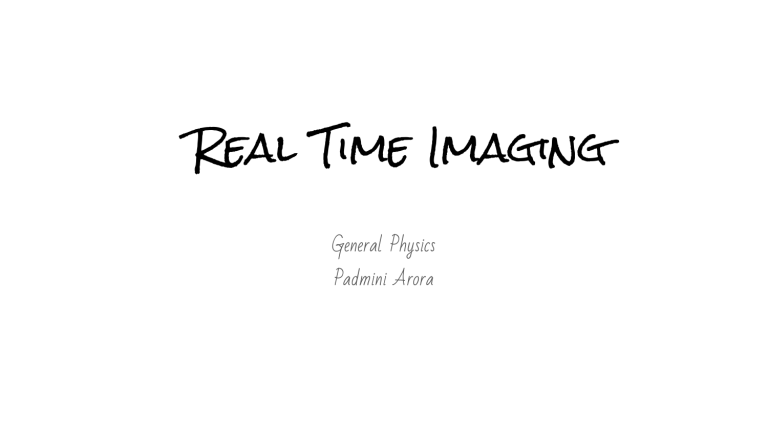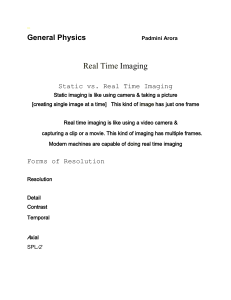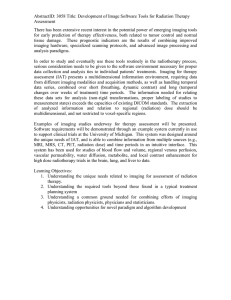
Real Time Imaging General Physics Padmini Arora Static vs. Real Time Imaging Static imaging is like using camera & taking a picture [creating single image at a time] This kind of image has just one frame Real time imaging is like using a video camera & capturing a clip or a movie This kind of imaging has multiple frames Modern machines are capable of doing real time imaging Resolution Contrast Detail Elevation Axial ↣ Elevation Beam Dimension ↣ SPL / 2 Lateral ↣ Lateral Beam Dimension ↣ Scan Converter ↣ [# Bits / Pixel] ↣ Post Processing Curves ↣ Monitor Settings ↣ Ambient Light ↣ Acoustic Impedance Mismatch Temporal ↣ Depth ↣ Packet Size [Color] ↣ Image Size ↣ Line Density ↣ Parallel Processing ↣ # Foci / Line ↣ Persistence ↣ Compound Imaging Temporal Resolution Temporal Resolution: Related to time ➷ Capturing moving structure with good resolution in time Frame rate: Ability of system to capture & display # of frames in 1 second OR how frequently system is generating & displaying frames on the screen ➷ Unit of frame rate: Hertz [Hz. or per second] ➷ Higher frame rate gives better temporal resolution ***[Most important factor affecting temporal resolution = frame rate]*** Frame Rate Factors affecting frame rate: ➷ Speed of sound in the medium ➷ Imaging depth If time required to make 1 frame = more #’s of frames generated in 1 second are less ➷ Meaning: frame rate & time required to generate 1 frame = inversely related to each other ➷ Relationship = T frame = 1 / frame rate OR T frame X frame rate = 1 ➷ if system generates 1 frame in 1/10 of a second = 10 frames per sec OR 10 Hz System Settings that affect Frame Rate ➷ T frame = # of pulses x PRP ⟡ A. Imaging depth with shallow depth ⤏ less go return time ⤏ shorter time to make a frame ⤏ higher frame rate ⤏ better temporal resolution & deep imaging ⤏ more go return time ⤏ more time to make a frame ⤏ lower frame rate ⤏ inferior temporal resolution ⟡ B. # of pulses in each picture: more the # of pulses ⤏ more the time it takes to make each frame ⤏ lower the frame rate ⤏ inferior temporal resolution Factors determining # of Pulses per Image ➷ 3 factors that affect # of pulses in each frame: ⟡ A. # of pulses per scan line [# of focal points]: 1 pulse can create 1 focus & 2 pulses are required for 2 foci & so on which means: more the # of foci → more the pulses are required to generate the frame → more the time required to generate a frame → less the frame rate ***multiple focus improves lateral resolution ⟡ B. Sector size: less the sector size → less the # of pulses → less the time it will take to generate the image → better the frame rate ⟡ C. Lines per angle of sector [Line density]: more the line density → more the pulses are there to generate frame → more the time it takes to generate a frame → less the frame rate ***High line density improves spatial resolution More about Temporal Resolution ➷ For still images: need better detail resolution ***temporal resolution = not concern ➷ For moving clip: need better temporal resolution [try using ⇊ sector, ⇊ # of focuses, ⇊ depth ✧ if you have an option of changing # of scan lines → use less # of scan lines ✔ all these steps will ⇊ time to generate frame → improves frame rate → improves temporal resolution







